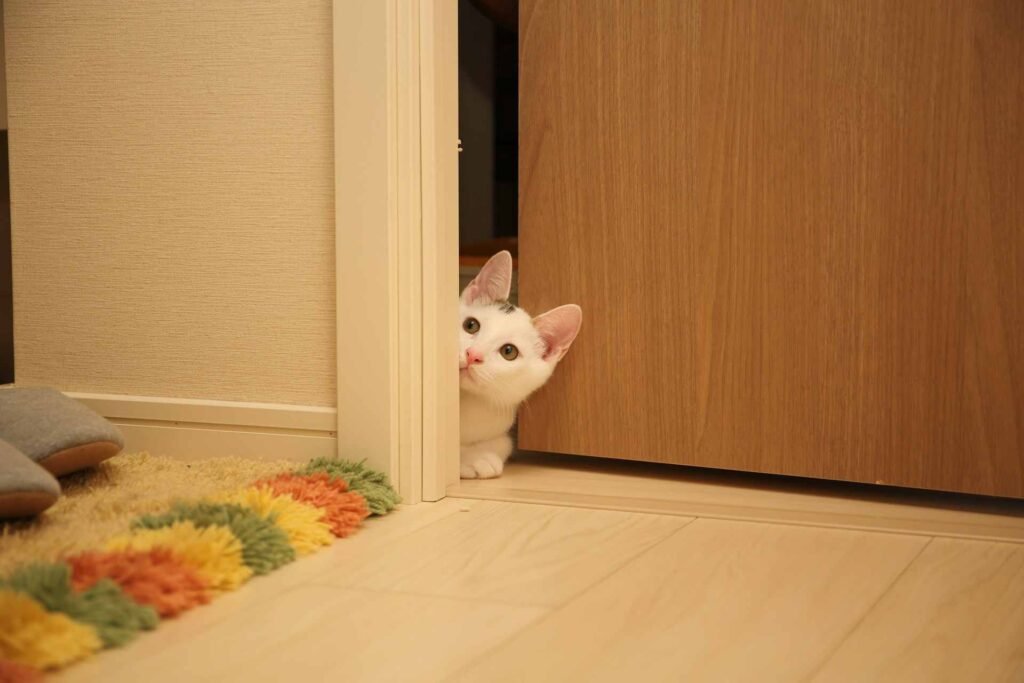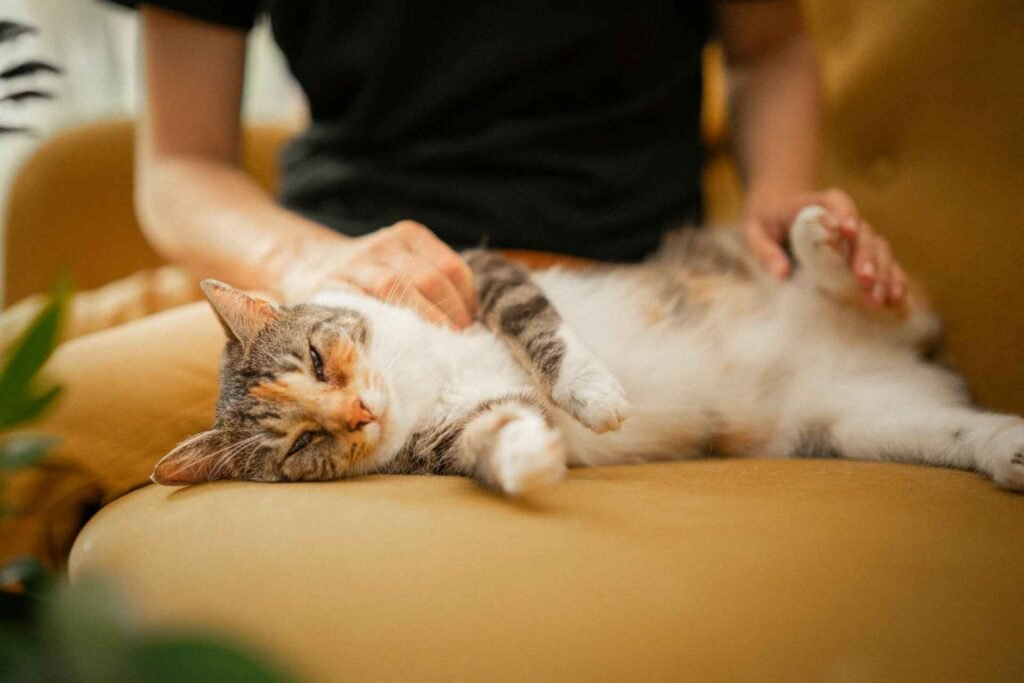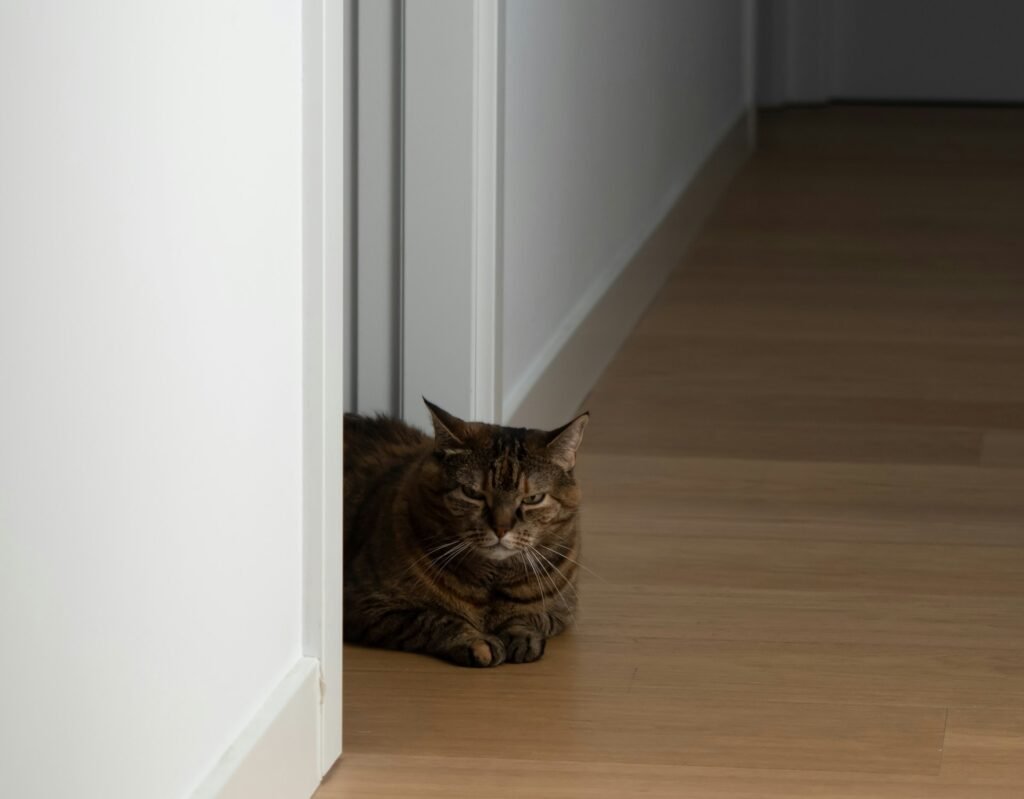There’s something almost comical about it. You step into the bathroom for just a moment, close the door behind you, and within seconds, a furry paw appears underneath, accompanied by increasingly dramatic meows. Your cat acts as though you’ve committed the ultimate betrayal, like you’ve just locked them out of the most important event of the century. Sound familiar?
If you’ve ever wondered why cats don’t like closed doors, you’re definitely not alone. This peculiar behavior has puzzled cat owners for generations, and honestly, it’s one of those things that makes living with cats both entertaining and occasionally frustrating. The good news? There’s actually solid reasoning behind this quirk, and understanding it can transform how you interact with your furry roommate.

The Territory Question: It’s All About Control
Let’s get something straight from the start. Your home isn’t really your home. At least not according to your cat. From their perspective, every square inch of your living space belongs to them, and they’ve worked hard to establish that ownership. Cats are incredibly territorial creatures, and this instinct runs deep in their DNA.
When you close a door, you’re essentially putting up a barrier in what your cat considers their kingdom. Imagine if someone suddenly cordoned off a section of your house without asking. You’d probably be pretty annoyed too, right? Your cat experiences something similar, except they lack the words to politely express their concerns (hence the pawing and yowling).
Territory isn’t just about space for cats. It’s about security, resources, and the ability to patrol and monitor their domain. They need to check their territory regularly, marking it with their scent and ensuring everything remains as it should be. A closed door disrupts this entire system, leaving them feeling uncertain and stressed about what might be happening on the other side.
Feline territorial behavior becomes especially important when you’re arranging your home. Creating vertical spaces and multiple pathways throughout your house gives cats alternative routes and vantage points, which can somewhat ease the anxiety caused by occasional closed doors.
Curiosity Never Killed This Cat (But It Did Make Them Persistent)
Beyond territory, there’s another powerful force at play: pure, unadulterated curiosity. Cats are natural-born investigators, and nothing triggers their detective instincts quite like a closed door. The moment you shut them out of a room, that space immediately becomes the most interesting place in the entire universe.
Think about it from their perspective. There could be anything behind that door. A mysterious sound, an intriguing smell, maybe even a rogue bug that needs immediate attention. Your cat’s brain goes into overdrive, imagining all the possibilities they’re missing out on. This feline version of FOMO (Fear of Missing Out) is very real.
Their hunting instincts also play a role here. In the wild, cats need to be aware of every sight, sound, and smell in their environment. A closed door blocks vital sensory information, leaving them unable to properly assess potential threats or opportunities. Even though your indoor cat isn’t exactly stalking prey in the savanna, these ancient instincts remain hardwired into their behavior.
Sometimes the door itself becomes the challenge. Cats are problem-solvers by nature, and many have figured out how to open doors using handles or by pawing them in just the right way. If your cat has mastered this skill, congratulations, you’re living with a feline genius who refuses to be outsmarted by basic home architecture.
The Social Side: They Actually Want to Be With You
Here’s where things get surprisingly sweet. Despite their reputation as aloof and independent creatures, many cats form deep bonds with their humans. When you close a door between yourself and your cat, you might trigger feelings of separation anxiety or social distress.
Cats are more social than most people realize. They’ve evolved alongside humans for thousands of years, and many genuinely enjoy our company (even if they have a funny way of showing it sometimes). When they hear you moving around on the other side of a door, they want to be part of whatever you’re doing, yes, even if that’s just brushing your teeth or folding laundry.

Some cats become particularly attached to specific family members and will follow them from room to room throughout the day. For these cats, a closed door feels like an unwelcome separation from their favorite human. They might display anxious behaviors like excessive meowing, scratching, or pacing because they genuinely miss your presence.
Signs of boredom or loneliness can sometimes intensify door-related behaviors. A cat who doesn’t have enough stimulation or social interaction during the day may become more clingy and resistant to being separated from you, even temporarily.
Understanding the Different Reactions
Not all cats react to closed doors the same way. Some will sit quietly outside, perhaps letting out an occasional chirp to let you know they’re there. Others launch into full-scale protests, complete with door scratching, handle rattling, and increasingly desperate vocalizations.
The intensity of your cat’s reaction often depends on several factors: their personality, past experiences, current stress levels, and whether they’re getting their basic needs met. A confident, well-adjusted cat with plenty of enrichment might barely notice a closed door, while an anxious or understimulated cat could become quite distressed.
Time of day matters too. Cats are naturally more active during dawn and dusk hours, and they might be more persistent about closed doors during these peak energy periods. If you’re trying to sleep with your bedroom door closed, and your cat is in full crepuscular mode, you might be in for a noisy night.
Some cats have also learned that making a fuss gets results. If you’ve ever given in and opened the door after your cat’s protests, you’ve essentially taught them that persistence pays off. They’re not being manipulative in a malicious way, they’re just smart enough to recognize patterns and use them to their advantage.
The Health and Comfort Factor
Beyond the psychological reasons, there are practical considerations too. Cats need access to their essential resources: food, water, litter boxes, and comfortable resting spots. A closed door that blocks access to any of these can cause genuine distress and even health issues.
Some cats are particular about where they eat or drink, and restricting access to their preferred spots can lead to reduced food or water intake.
Temperature regulation is another often-overlooked factor. Cats seek out warm or cool spots depending on their comfort needs. A closed door might block access to their favorite sunny window perch in winter or the cool tile floor in summer. This can leave them feeling physically uncomfortable on top of emotionally stressed.
Health issues can also exacerbate door-related behaviors. An older cat with cognitive decline might become confused or anxious when doors are closed. Similarly, a cat experiencing pain or discomfort might be less tolerant of barriers and restrictions in their environment.
Creating a Peaceful Coexistence With Doors
So what’s a cat owner to do? You can’t exactly leave every door in your house open 24/7 (though your cat would certainly appreciate it). The key lies in finding a balance between your needs for privacy and boundaries, and your cat’s needs for access and security.
Strategic Door Management
Consider which doors really need to be closed and which can remain open most of the time. Rooms that contain hazards or valuables might need to stay off-limits, but perhaps other areas can remain accessible. The more consistent you are about which doors stay closed, the easier it becomes for your cat to adjust their mental map of their territory.

For doors that must remain closed sometimes, try to minimize how often this happens. If you’re working in a home office, leaving the door cracked or installing a baby gate might give your cat visual access without allowing them to disrupt your workspace. This way, they can still feel included without being physically present.
Installing cat-friendly door solutions like pet doors or door latches that cats can’t open but that leave a small gap at the bottom can work wonders. These allow your cat to move freely while still maintaining some separation when needed. There are even motion-activated doors designed specifically for pets that respond to special collars.
Enrichment and Distraction
When you do need to close a door, having plenty of alternative entertainment available makes a huge difference. Interactive toys and puzzle feeders can redirect your cat’s attention away from the closed door and toward something more engaging.
Consider setting up particularly appealing spaces on the opposite side of the house from commonly closed doors. A window perch with a bird feeder view, a cozy heated bed, or a new scratching post might be enough to capture your cat’s interest when you need some alone time.
Timing also matters. If you know you’ll need privacy at certain times, try scheduling play sessions beforehand to tire out your cat. A good interactive play session with a wand toy can leave them more relaxed and less concerned about closed doors. You might also try coordinating door closures with meal times, a cat busy eating is less likely to protest your bathroom break.
Training and Positive Reinforcement
Yes, you can actually train cats (despite what some people might tell you). The key is using positive reinforcement rather than punishment. When your cat remains calm near a closed door, reward them with treats or praise. This teaches them that closed doors aren’t inherently threatening.
Start with short door closures and gradually increase the duration as your cat becomes more comfortable. If you’re trying to train your cat to accept a bedroom door being closed at night, begin by closing it for just a few minutes during the day when you’re on the same side as your cat. Reward calm behavior, then gradually extend the time and eventually move to the other side of the door.
Never punish your cat for door-related protests. Yelling, spraying water, or showing frustration will only increase their anxiety and potentially damage your bond. Remember, from their perspective, they’re responding to what feels like a genuine problem. Patience and consistency will get you much further than frustration.
Creating Safe Zones
For situations where you need to confine your cat to one area, make sure that space contains everything they need. Set up a cozy room with food, water, a clean litter box, comfortable bedding, toys, and ideally a window view. Adding an item with your scent, like a worn t-shirt, can provide comfort.
Creating comfortable sleeping spaces in multiple rooms gives your cat options and reduces the feeling of being restricted to just one area. The more comfortable and enriched their accessible spaces are, the less they’ll fixate on closed doors.
Some cats benefit from pheromone diffusers placed in rooms where they spend time when doors are closed. These products release calming scents that can reduce anxiety and help cats feel more secure, even when separated from parts of their territory.
The Reality of Compromise
Living with cats means accepting some compromises. Your home will never be perfectly organized the way it might be without pets. There will be fur on the couch, toys scattered across the floor, and yes, probably some doors you can’t fully close without staging a feline intervention.

But here’s the thing: these quirks are part of what makes cats such fascinating companions. Their strong personalities, territorial instincts, and curious nature create the unique dynamic that makes life with cats never boring. Understanding why cats don’t like closed doors doesn’t just solve a behavioral puzzle, it deepens your appreciation for how your cat experiences and interacts with their world.
Most cats can learn to accept some closed doors with patience and proper management. It’s about finding that sweet spot where both you and your cat feel comfortable. Maybe that means leaving your bedroom door cracked at night, or perhaps it means training your cat to accept a closed bathroom door for brief periods.
Practical Solutions at a Glance
| Challenge | Solution | Why It Works |
|---|---|---|
| Nighttime door scratching | Interactive play before bedtime + automated feeder set for early morning | Tires out cat and addresses early morning hunger motivation |
| Protest meowing at bathroom door | White noise machine or calming music outside door | Masks sounds that trigger curiosity, reduces auditory stimulation |
| Territorial anxiety | Maintain open access to majority of home, consistent closure schedule | Provides security through predictable access to most territory |
| Separation distress | Gradual desensitization training with treats | Builds positive associations with brief separations |
| Resource access concerns | Multiple feeding stations, water bowls, and litter boxes | Ensures cat isn’t genuinely blocked from necessities |
When implementing these solutions, remember that consistency matters more than speed. Rushing the process or constantly changing your approach will only confuse your cat. Pick a strategy that works for your household and stick with it long enough to see results.
FAQ
Why does my cat meow at closed doors at night specifically?
Cats are naturally more active during dawn and dusk hours, which means nighttime often coincides with their peak energy periods. When your cat meows at closed doors at night, they’re often experiencing heightened instincts to patrol territory, hunt, and interact. They may also hear you moving around in the bedroom and want to join you, or they might be seeking early morning breakfast. Adjusting their feeding schedule and engaging in vigorous play sessions before your bedtime can reduce nighttime door protests significantly.
Can cats develop anxiety from closed doors?
Yes, some cats can develop genuine anxiety related to closed doors, especially if those doors block access to important resources or favorite people. Cats with separation anxiety or those who have experienced trauma may be particularly susceptible. Signs of door-related anxiety include excessive vocalization, destructive scratching, pacing, refusing to eat, or eliminating outside the litter box. If your cat shows these symptoms, gradually desensitizing them to closed doors through positive reinforcement training can help, though severe cases may benefit from consultation with a veterinary behaviorist.
Is it cruel to keep certain rooms off-limits to cats?
Not necessarily. Having some off-limit rooms is perfectly acceptable as long as your cat has adequate space, resources, and enrichment in the areas they can access. The key is consistency and ensuring your cat’s basic needs are always met. If you keep a room closed, it should stay closed all the time so your cat adjusts their mental territory map accordingly. Problems arise when access is inconsistent or when too much of the home becomes restricted. As long as your cat has room to explore, comfortable places to rest, and access to food, water, and litter boxes, having a few closed-off rooms shouldn’t cause issues.
Why does my cat scratch at the door but then not want to come in?
This frustrating behavior often comes down to curiosity and control rather than an actual desire to enter. Your cat might simply want to know they could come in if they chose to. The act of scratching and getting you to open the door satisfies their need to maintain control over access to their territory. Once they’ve confirmed what’s on the other side and that they have the option to enter, they may decide they’re not actually interested.
Do all cats hate closed doors?
Not all cats react strongly to closed doors. Some cats, particularly those raised with consistent boundaries from kittenhood, accept closed doors as normal parts of their environment. Others may be naturally more independent or simply less territorial. Factors like breed traits, individual personality, early socialization, and past experiences all influence how a cat responds to closed doors. While the behavior is common, it’s not universal, and even cats who initially protest closed doors can often be trained to accept them better over time.
Will getting another cat help with door anxiety?
This depends entirely on your individual cat and their specific reasons for door-related behaviors. For cats whose door protests stem from loneliness or boredom, having a feline companion might provide enough social interaction and play to reduce their focus on closed doors. However, for cats driven primarily by territorial instincts, adding another cat could actually increase stress and make door behaviors worse as they feel the need to defend their territory more vigilantly.
Conclusion: Living in Harmony With Your Feline Overlord
At the end of the day, cats don’t like closed doors because those doors challenge everything they hold dear: control, access, curiosity, and connection. Your cat isn’t being difficult for the sake of it (well, mostly). They’re simply expressing deeply ingrained instincts that have kept their species thriving for thousands of years.
The beauty of understanding these behaviors is that it takes the frustration out of the equation. Instead of seeing your cat as an annoying pest who won’t let you use the bathroom in peace, you can recognize them as a territorial creature trying to maintain order in their world. It’s actually kind of endearing when you think about it, your cat cares so much about their home (which includes you) that they can’t stand being separated from any part of it.
So the next time you hear that telltale scratching or those plaintive meows outside a closed door, take a deep breath and remember: your cat isn’t plotting your downfall (probably). They’re just being authentically, wonderfully, frustratingly cat. And honestly, would you really want them any other way? At least their antics keep life interesting and give you endless stories to share with fellow cat owners who understand the struggle all too well.
Looking for more? Visit our Blog for more fun and insightful reads, or browse our full Cat Category for everything feline-related, from care to comfort.
Disclaimer: This article is for informational purposes only and does not substitute for professional veterinary advice. Always consult your veterinarian for diagnosis and treatment tailored to your cat’s individual needs. Please verify current product information directly on the retailer’s site before purchasing.
Check out our most recent articles!
- Why Cats Don’t Like Closed Doors and What to Do About ItThat closed door you just shut? Your cat considers it an unwelcome barrier in their kingdom. Discover what drives this persistent behavior and learn practical strategies to create harmony between your need for privacy and your cat’s territorial nature.
- Different Types of Cat Carriers Explained: How to Choose the Right OneFrom nervous rescues to confident adventurers, every cat needs a carrier that fits their personality. Discover which type works best for your situation and how to help your cat actually accept their carrier without the usual drama.
- Funny Names for White Cats: Hilarious & Creative IdeasWhite cats deserve names as entertaining as their personalities. From sophisticated wordplay to hilariously ironic choices, discover how the right funny name transforms daily interactions with your snowy feline into endless moments of joy.
- Why Are Dogs Afraid of Thunder But Cats Aren’t (Usually)?Not all pets react the same way to thunderstorms, and there are solid biological reasons why. Understanding what makes dogs more storm-sensitive than cats helps you provide better support when severe weather strikes your area.
- DIY Halloween Costumes for Cats That Actually WorkNot all cats approach Halloween costumes the same way, which is why DIY designs win every time. From five-minute bandanas to elaborate bat wings, discover costume ideas that match your cat’s tolerance level while creating memorable moments you’ll treasure for years.
- The Best Spooky Cat Toys for This Halloween SeasonYour cat deserves to celebrate Halloween too, and the right toys make it happen. Discover why seasonal toys create more engagement than year-round options and how to choose the perfect spooky playthings for your feline’s unique personality.
- Safe Halloween Treats for Cats: Halloween Recipes and Portion GuidelinesForget the complicated recipes and store-bought novelty items. The simplest, safest, and most meaningful Halloween treats for your cat are probably already in your kitchen right now.
- Are Cats Scared of the Dark? Feline Nighttime Behavior ExplainedYour cat’s relationship with darkness is more complicated than simply “scared” or “fearless.” While cats boast impressive night vision, they can’t see in complete blackness, and what really unsettles them at night might surprise you.
- Funny Cat Halloween Costumes: From Pumpkins to VampiresHalloween costumes for cats have evolved from basic accessories to elaborate character transformations. Whether your feline embraces the vampire aesthetic or grudgingly tolerates a pumpkin hat, this guide helps you find comfortable, photo-worthy costumes that respect your cat’s boundaries while maximizing the adorable factor.
- Can You Give Cats Canned Pumpkin? Everything You Need to KnowCanned pumpkin has earned its reputation as a go-to remedy for cat digestive issues, but knowing when and how much to use makes all the difference. From understanding the fiber benefits to avoiding dangerous pumpkin pie filling, smart cat owners need the full picture before reaching for that orange can.










